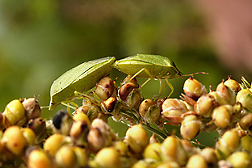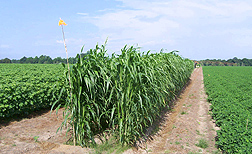Controlling Native Stink Bugs in the Southeast
|
|
The invasive brown marmorated stink bug (Halyomorpha halys) has become a familiar nuisance in many areas of the United States, but three native stink bugs have been attacking crops for decades in Georgia and other parts of the Southeast. The southern green stink bug (Nezara viridula) and the brown stink bug (Euschistus servus) will damage corn, and both can develop in peanut and move into cotton to cause damage as adults. The green stink bug (Chinavia hilaris) will damage cotton after moving into it from noncrop sources at field edges. All three are immune to the Bt toxin that controls other insects in corn and cotton, so growers often spray “broad-spectrum” insecticides, which kill not only stink bugs, but also beneficial insects.
Agricultural Research Service entomologist Patricia Glynn Tillman, who is in the Crop Protection and Management Research Unit in Tifton, Georgia, has found ways to help growers reduce losses and adopt greener alternatives. Results of her studies highlight the effectiveness of several innovative strategies, including the use of nectar-producing plants to attract beneficial insects and the placement of barriers between crops to discourage migrations.
|
|
Where Do They Go?
Each spring, many farmers in Georgia plant corn first, then peanuts, and then cotton, often near each other or side-by-side. Using hand-held nets and drop cloths, Tillman and her colleagues collected stink bugs from the three crops for 6 years to study stink bug migration patterns.
In one report, they evaluated the influence of different types of plants along field edges on stink bug dispersal, whether adjacent woodlands contribute to infestations, and the effects of plant height on how far the pests penetrate into fields.
They found that brown stink bugs and southern green stink bugs are present in all three crops and often migrate from one crop to the next, and that green stink bugs are rare in corn and peanut, but common in cotton. They also found that stink bugs are likely to migrate into cotton from adjacent woodlands and into corn from both woodlands and nonwooded areas. The height of the crop also made a difference: The taller the crop plant, the less penetration occurred. Results were published in 2014 in the Bulletin of Entomological Research.
They also evaluated stink bug colonization in three cropping systems common in the Southeast: corn/cotton, corn/peanut/cotton, and peanut/cotton. Results showed that for southern green stink bugs and brown stink bugs, the risk of colonizing cotton was highest in corn/peanut/cotton cropping systems, and for green stink bugs, the risk was highest in peanut/cotton systems. Green stink bugs are more attracted to cotton than to corn, but corn is more likely than cotton or peanuts to harbor southern green stink bugs and brown stink bugs.
|
|
Stink bugs have long been more of a concern for cotton and corn growers than for peanut producers, but the results show that peanut growers also have reason for concern. While peanuts are a poor host for green stink bugs, southern green stink bugs and brown stink bugs grow and develop in peanuts, and both subsequently will move readily into cotton and cause significant damage. Results were published in 2013 in Environmental Entomology.
Barriers Can Help
Tillman also placed barriers between crops to see if they would prevent stink bugs from migrating from one crop to another. She also evaluated whether nectar-producing plants will attract beneficial parasitoids that control stink bugs. In one study, she placed nectar-producing buckwheat plants, sorghum Sudan grass (an annual grass that grows to about 8 feet), and plastic sheets of two different heights (about 6 feet high and about 2 feet high) between peanut and cotton fields to assess their effectiveness as barriers. The grass and plastic sheets were erected specifically to see if they would prevent stink bugs from migrating from low-growing peanut plants into cotton. She found that the plastic and the grass were effective, as long as the barriers were at least as high as the cotton (4.5 feet). She also found that the buckwheat attracted the parasitoid Trichopoda pennipes, which cut back on stink bugs in nearby cotton. Results were published in 2014 in the Journal of Pest Science.
Finally, Tillman and her colleagues placed potted milkweed plants about 4 feet from each other along the edges of cotton fields in peanut/cotton production areas and sampled the cotton for levels of stink bugs and T. pennipes. They found significantly higher numbers of T. pennipes parasitizing stink bugs in cotton near nectar-producing milkweed than in control plots. They also reported an unrelated benefit: The milkweed attracted Monarch butterflies, an eye-catching migratory species that has prompted concern among conservationists because of the loss of milkweed habitat. Results were published in 2014 in Environmental Entomology.
The strategies will not eradicate stink bugs, but the studies show they will help. “These measures have the potential to provide some control of stink bug populations, but they will work best if used as one part of an overall management plan,” Tillman says.—By Dennis O'Brien, Agricultural Research Service Information Staff.
This research is part of Crop Protection and Quarantine, an ARS national program (#304) described at www.nps.ars.usda.gov.
Patricia Glynn Tillman is in the USDA-ARS Crop Protection and Management Research Unit, 2747 Davis Rd., Tifton, GA 31793; (229) 387-2375.
"Controlling Native Stink Bugs in the Southeast" was published in the November/December 2014 issue of Agricultural Research magazine.









